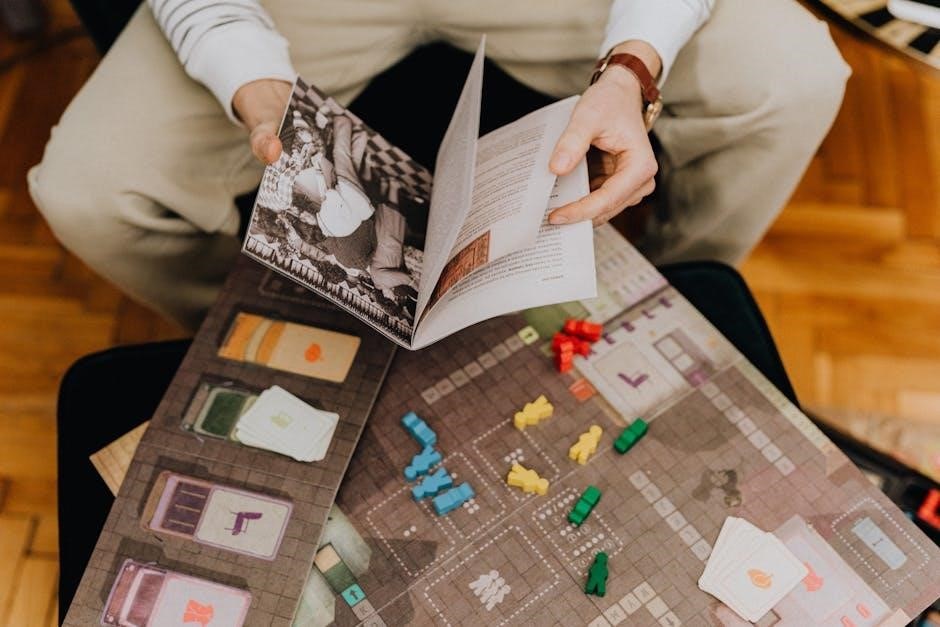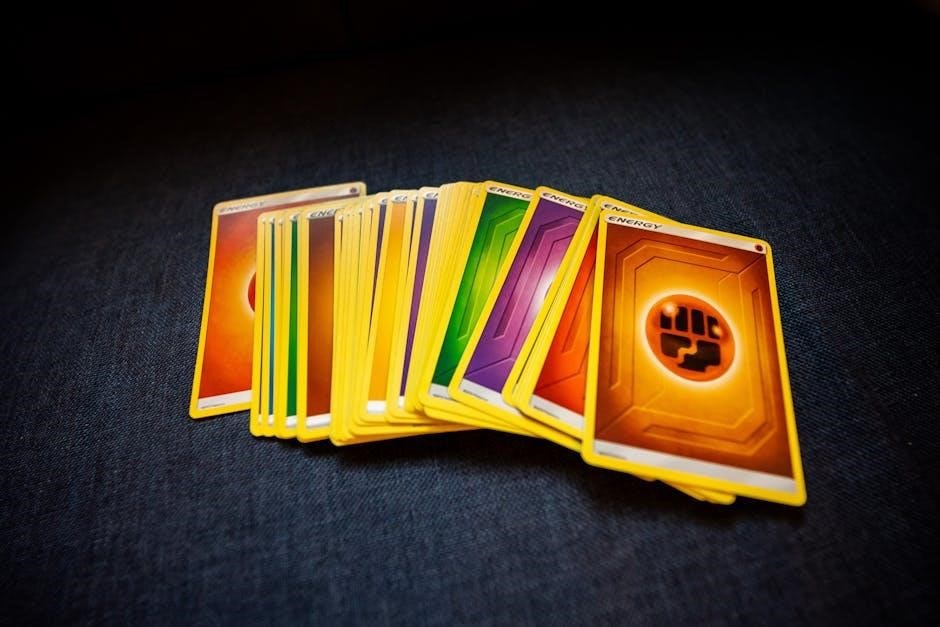
The Trash Card Game, also known as Garbage or I Doubt It, is a fast-paced, entertaining card game where players aim to be the first to arrange all ten cards in sequence from Ace to 10. Simple rules, luck, and strategy make it enjoyable for all ages, perfect for quick gameplay sessions.
Overview of the Game
The Trash Card Game, often referred to as Garbage, is a simple yet engaging card game where players aim to arrange their cards in sequential order from Ace to 10. This game is known for its quick-paced nature and straightforward rules, making it accessible to players of all ages. Each player starts with a set of face-down cards, which they gradually replace with numbered cards (A-10) drawn from the stockpile. The game also incorporates wild cards, adding an element of strategy and unpredictability. Its popularity stems from its ease of play and the fact that it can be enjoyed in both casual and competitive settings. Whether played solo or with multiple players, the Trash Card Game offers a fun and mentally stimulating experience.
Historical Background and Popularity
The Trash Card Game, also known as Garbage or I Doubt It, has a long-standing presence as a beloved card game across various demographics. Originating as a simple, fast-paced game, it gained popularity for its ease of play and entertainment value. Often enjoyed by children for its numerical sequencing and by adults as a quick pastime, its versatility has made it a staple in casual gatherings. The game’s straightforward rules and reliance on luck and strategy have contributed to its enduring appeal. Additionally, its association with events like Waste & Recycling Workers Week has further cemented its place in popular culture. Over time, variations and house rules have emerged, allowing the game to adapt to different player preferences while maintaining its core charm. Its widespread acceptance and adaptability ensure its continued enjoyment across generations.

Setup and Initial Rules
The game begins with each player receiving 10 face-down cards, arranged in two rows of five. The remaining cards form a stockpile for drawing. Players cannot view their cards initially.
Number of Players and Decks Required
The Trash Card Game is versatile, accommodating 2 to 6 players. For 2 players, one standard 52-card deck is sufficient. With 3-4 players, two decks are required, while 5-6 players need three decks. Each player receives 10 face-down cards, arranged in two rows of five. The remaining cards form the stockpile, used for drawing during gameplay. The number of decks ensures there are enough cards for all players to participate without running out of options. This setup balances gameplay duration and complexity, making it suitable for various group sizes. The face-down arrangement adds an element of surprise, as players initially cannot see their cards.
Dealing the Cards
In the Trash Card Game, the dealer shuffles the deck(s) and distributes 10 cards to each player, face down. Players are not allowed to look at their cards initially. These 10 cards are arranged in two rows of five cards each, forming the player’s layout. The remaining cards are placed face down in the center of the table to create the stockpile, which will be used for drawing during gameplay. The face-down cards in each player’s layout represent the starting point, and players must strategically replace them with numbered cards (Ace to 10) as the game progresses. This setup ensures that the game begins with an element of surprise, as players do not know their initial card positions. The dealer then oversees the game, ensuring all rules are followed correctly.
Initial Layout and Face-Down Cards
Once the cards are dealt, each player arranges their 10 face-down cards into a specific layout, typically two rows of five cards each. These face-down cards serve as placeholders that players aim to replace with numbered cards (Ace through 10) during the game. The layout is crucial, as it dictates where each numbered card must be placed when drawn. Players are not allowed to look at or rearrange their face-down cards at the start of the game, adding an element of surprise and strategy. The remaining cards are placed face down in the center of the table, forming the stockpile, which will be used for drawing during gameplay. This initial setup ensures all players begin on equal footing, with the goal of replacing face-down cards to complete the sequence from Ace to 10.

Gameplay Mechanics
Gameplay involves drawing from the stockpile, placing numbered cards (A-10) in sequence, utilizing wild cards strategically, and mandatory discards that end each player’s turn, maintaining the game’s swift pace.
Drawing Cards from the Stockpile
The game begins with each player drawing a card from the stockpile. If the drawn card is a numbered card (A-10), it replaces the corresponding face-down card in their layout, which is then turned face-up. This action is key to progressing through the game, as players aim to reveal and arrange their cards in sequence. The face-down card removed from the layout is then placed in its appropriate position if possible, continuing the cycle of revealing and organizing. Players take turns drawing from the stockpile, ensuring the game moves at a steady pace as they strive to complete their sequence from Ace to 10. This mechanic is central to the gameplay, driving the strategic placement of cards and the eventual reveal of all face-down cards.
Placing Numbered Cards (A-10)
Players place numbered cards (A-10) in their designated spots by drawing from the stockpile. When a numbered card is drawn, it replaces the face-down card in the corresponding position, which is then turned face-up. For example, an Ace goes in the top-left spot, a 2 next to it, and so on. This process allows players to gradually reveal their layout and work toward completing the sequence. If a drawn card cannot be placed, the player must discard it, ending their turn. The ability to strategically place numbered cards is crucial, as it directly impacts progress toward winning. Variations may also allow players to place cards from the discard pile, adding an extra layer of strategy to the game. The goal remains to be the first to have all cards face-up in the correct order.
Using Wild Cards and Special Rules
Wild Cards add excitement and strategy to the Trash Card Game. These cards can be placed in any numbered position (A-10), allowing players to fill gaps strategically. In some variations, Wild Cards can also be used to block opponents or force them to draw extra cards. Special rules, such as “Trashed” cards, enable players to steal face-up cards from others, adding a competitive edge; Stop Cards can halt opponents’ turns, preventing them from placing cards. These special cards create unpredictability and require players to adapt quickly. Variations may also include rules like “multiple card plays,” where players can place several cards in one turn if they match the sequence. Mastering Wild and special cards enhances gameplay and increases chances of winning, making them a key part of advanced strategies.
Mandatory Discards and Turn End
In the Trash Card Game, a player’s turn ends when they cannot place a drawn card in their layout. If the card drawn from the stockpile is not an Ace through 10, or if it cannot be placed in the correct position, the player must discard it face-up. This discard is placed beside the stockpile, creating a visible discard pile. The turn then passes to the next player. Mandatory discards ensure that players must strategically manage their moves, as unused cards can no longer be played once discarded. The face-up discard pile provides valuable information to other players, allowing them to infer which cards remain in play. This rule adds a layer of unpredictability and strategy, as players must adapt based on the cards that have been discarded. Proper management of discards is crucial for optimizing gameplay and increasing chances of winning.

Winning Conditions
Winning the Trash Card Game requires being the first player to complete the sequence from Ace to 10. The game ends immediately when a player achieves this, and subsequent rounds follow the same rules, often granting the winner a strategic advantage.
Completing the Sequence (A-10)
The primary objective of the Trash Card Game is to be the first player to replace all ten face-down cards with face-up cards in sequential order from Ace to 10. Players achieve this by drawing cards from the stockpile and strategically placing them in their designated layout. The layout consists of two rows of five cards each, with each position corresponding to a specific number (Ace through 10). When a player draws a numbered card, they place it in the correct spot, flipping over the face-down card and potentially creating a chain reaction if the revealed card can be used elsewhere. Wild cards can also be used to fill gaps, adding flexibility to the gameplay. The game concludes as soon as one player successfully arranges all ten cards in the correct order, making them the winner.
Being the First to Finish
In the Trash Card Game, the ultimate goal is to be the first player to completely flip over all ten face-down cards in their layout, arranging them in the correct numerical order from Ace to 10. The game ends immediately when a player achieves this, and they are declared the winner. The race to finish first adds an exciting competitive edge, as players must strategically draw and place cards to outpace their opponents. Once a player wins a round, they gain an advantage in the next round by receiving one fewer card than the other players, making it slightly easier for them to win again. This rule ensures that the game remains dynamic and challenging, rewarding quick thinking and efficient card placement.
Rules for Subsequent Rounds
After the first round, subsequent rounds of the Trash Card Game follow similar rules but with a key adjustment: the winner of the previous round starts with one fewer card than the other players. For example, if others receive ten cards, the winner gets nine. This rule adds a layer of strategy and balance, as the winner has a slight advantage while others must work harder to catch up. The game continues with these adjusted rules until a predetermined number of rounds have been played or a single player emerges as the overall winner. This format ensures that each round remains competitive and exciting, keeping players engaged and eager to outperform their opponents in the next round.

Variations and Special Rules
The Trash Card Game allows for creative variations, including the use of wild cards and special actions like stealing cards from opponents, enhancing gameplay excitement and strategy opportunities for players.
Playing with Multiple Players
The Trash Card Game is designed for 2 to 6 players, with the number of decks increasing as more players join. For two players, one standard deck is used, while three to four players require two decks, and five to six players need three decks. This scalability ensures the game remains dynamic and engaging. When playing with multiple players, the objective remains the same: to be the first to arrange all ten cards in sequence from Ace to 10. The game becomes more competitive as players can interfere with each other’s progress by stealing cards or using wild cards strategically. The social interaction and unpredictability of multiple players make the game lively and entertaining for everyone involved. Players must stay attentive to others’ moves to maximize their chances of winning.
House Rules and Customizations
House rules and customizations are a popular way to enhance the Trash Card Game, allowing players to tailor the experience to their preferences. Common variations include introducing additional wild cards or special action cards, such as “Trash” cards that let players steal face-up cards from opponents. Some groups also implement rules like “freezing” a player’s turn or allowing multiple cards to be placed in a single turn. Customizations can also include penalty systems for losing rounds or rewarding strategic plays. Players often adapt the game to suit different age groups or skill levels, such as simplifying rules for younger players or adding complexity for advanced strategists. These customizations ensure the game remains fresh and exciting for recurring players while maintaining its core objective of sequencing cards from Ace to 10.
Adapting the Game for Different Ages
The Trash Card Game can be easily adapted to suit different age groups, making it accessible and enjoyable for players of all skill levels. For younger children, the game can be simplified by focusing on basic number recognition and sequencing, with adults or older siblings guiding them through the rules. Teens and adults can enjoy the game as a quick, competitive activity, with optional additional rules like penalties for losing rounds or team-based gameplay to increase engagement. For older adults, the game’s straightforward nature makes it a great option for casual entertainment. By adjusting complexity and adding optional variations, the Trash Card Game remains versatile and appealing to a wide range of ages, ensuring everyone can participate and have fun.
Advanced Strategies
Experienced players optimize card placement, use wild cards strategically, and employ psychological tactics to outmaneuver opponents, ensuring efficient progression toward completing the sequence and securing a win.
Optimizing Card Placement
Optimizing card placement is crucial for success in the Trash Card Game. Players should prioritize placing lower-numbered cards, such as Aces, early to build a strong foundation for the sequence. Strategically using wild cards to fill gaps ensures progress, while minimizing wasted moves; Paying attention to the cards opponents discard can provide insights into their layouts, allowing for informed decisions. Maintaining an organized layout helps track which numbers are still needed, enabling efficient use of drawn cards. By focusing on high-probability placements and avoiding unnecessary discards, players can accelerate their progress toward completing the sequence from Ace to 10, ultimately gaining an edge over competitors.
Using Wild Cards Effectively
Wild cards are a powerful tool in the Trash Card Game, allowing players to fill gaps in their sequence. They can be used as substitutes for any numbered card (A-10), providing flexibility when completing the layout. To maximize their impact, players should save wild cards for critical gaps that are difficult to fill with drawn cards. Timing is essential; using a wild card too early may waste its potential, while waiting too long might delay progress. Additionally, wild cards can be strategically placed to disrupt opponents by forcing them to discard or lose turns. Effective use of wild cards requires balancing immediate needs with long-term strategic goals, ensuring they are deployed at the most advantageous moments to accelerate progress toward completing the sequence from Ace to 10.
Psychological Tactics in Gameplay
Psychological tactics play a subtle yet impactful role in the Trash Card Game, where players can influence opponents’ decisions and perceptions. A key strategy is to bluff about the progress of your sequence, making opponents doubt your moves or question their own. For instance, players can pretend to have certain cards or hide their actual progress to mislead others. Additionally, the ability to steal face-up cards from opponents using special cards creates tension and forces players to think defensively. Timing actions strategically, such as discarding cards or using wild cards, can also pressure opponents into making mistakes. The psychological aspect adds depth to the game, as players must balance their focus on completing their own sequence while attempting to disrupt others. This mental interplay enhances the game’s appeal, making it more than just a luck-based activity.
The Trash Card Game offers a fast-paced, family-friendly experience. For official rules and detailed guides, visit Trash Card Game Rules PDF and explore resources like wikiHow.
Final Tips for Mastery
To master the Trash Card Game, focus on optimizing card placement and strategically using wild cards. Pay attention to opponents’ moves to anticipate their progress. Practice solo rounds to refine your skills and reaction time. Memorize the layout to quickly identify where each card belongs. Use face-down cards wisely, as they can block opponents or reveal crucial information. Timing is key—discard unusable cards early to avoid wasting turns. Stay observant and adapt your strategy based on the cards drawn. Mastering these tactics will enhance your gameplay and increase your chances of winning. Regular practice and strategic thinking are essential to becoming a Trash Card Game expert.
Where to Find Official Rules (PDF)
Official Trash Card Game rules can be found in various online resources. Websites like Skiptomylou and WikiHow offer detailed PDF guides. Additionally, platforms such as GitHub host LaTeX sources and rendered PDFs for the game. You can also search for “Trash Card Game Rules PDF” on major search engines to access downloadable files. These resources provide comprehensive instructions, including setup, gameplay, and winning conditions. Ensure you refer to trusted sources for accurate and up-to-date information to enjoy the game fully. Downloading these PDFs is a great way to share the rules with friends or keep a handy reference during play;